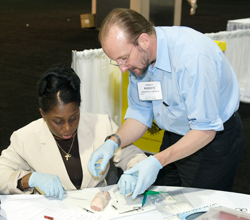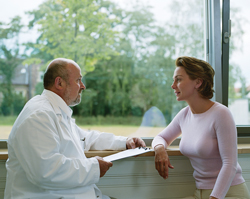Use your hands, not just your mind, at Internal Medicine 2010
Preview upcoming attractions and sessions of the College's annual meeting, being held this year in Toronto. Find events occurring at the meeting, or for those not going, find out how to follow news as it happens.
Whether they're going eye-to-eye with a disembodied head or opening the airway of a mannequin, attendees at Internal Medicine 2010, to be held April 22-24 in Toronto, will find a number of opportunities for hands-on training.
The Herbert S. Waxman Clinical Skills Center, an annual feature of the meeting, includes several new activities this year. The aforementioned heads are part of the debut of the ophthalmology station, an educational resource developed in-house by ACP. “This is our first foray into making our own simulator,” said Patrick Alguire, FACP, director of education and career development for ACP.

The activity consists of mannequin heads (like those used in wig stores) with models of the human eye implanted in them. “We've done a little surgery on the mannequin heads,” said Dr. Alguire. Participants will use ophthalmoscopes to view various abnormalities of the eye.
The exhibit may also provide ideas for educators wanting to create simulators for their own institutions, suggested Dr. Alguire. They'll have plenty of time to admire the handiwork, because the ophthalmology activity is self-guided. “You can sit there and stare as long as you want,” said Dr. Alguire. “This is a low-pressure way to learn.”
Attendees will gain some training for high-pressure situations in one of the center's other new activities—the advanced airway workshop. Participants will practice intubation on mannequins, learn the advantages and disadvantages of rapid sequence intubation, and pick up rescue techniques in case of failed intubation.
“They practice over and over and get expert advice,” said Dr. Alguire. “I anticipate it's going to be a real success.” Because it includes faculty, the airway simulation, unlike the ophthalmology activity, does require tickets. (Tickets are free and can be obtained onsite at the meeting.)
The other new activities in the center are also likely to bring success, particularly to physicians who are working or training in the hospital. A lumbar puncture training exercise will include demonstration, practice on a simulator and expert feedback. The new peripherally inserted central catheter (PICC) activity will give physicians the chance to practice placement of PICC lines, using simulators and hand-carried ultrasounds.
Other old favorites will also be returning this year, of course, including toenail removal, Harvey the cardiopulmonary patient, and the self-guided cardiac murmurs tour.
For attendees who want hands-on action outside of the Waxman Clinical Skills Center, Internal Medicine will include two new pre-courses. On Tuesday, “Fundamentals of Mechanical Ventilation” will serve as a refresher on topics such as the management of ARDS and asthma patients. “Advanced Concepts in Mechanical Ventilation” on Wednesday will address novel techniques and new modes of ventilation. Both sessions will include break-out small group sessions featuring live ventilators, mannequins and simulators.
The general scientific program will also include several new hands-on workshops. Internists can practice insertion and removal of intrauterine contraceptive devices during a session on highly effective reversible contraception that will be held Thursday morning and afternoon.
Communication skills will be put to the test in new workshops on breaking bad news, treating patients across language barriers, and managing memory loss and incontinence. Not to worry, though, there will be no simulations of incontinence included.




